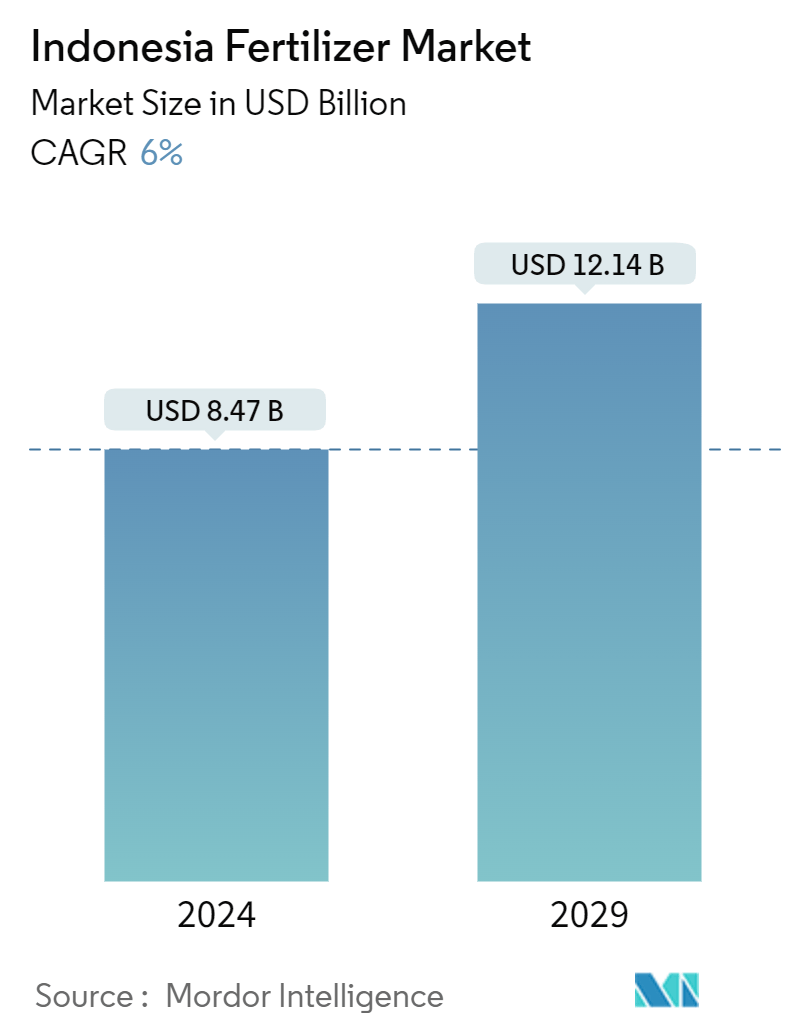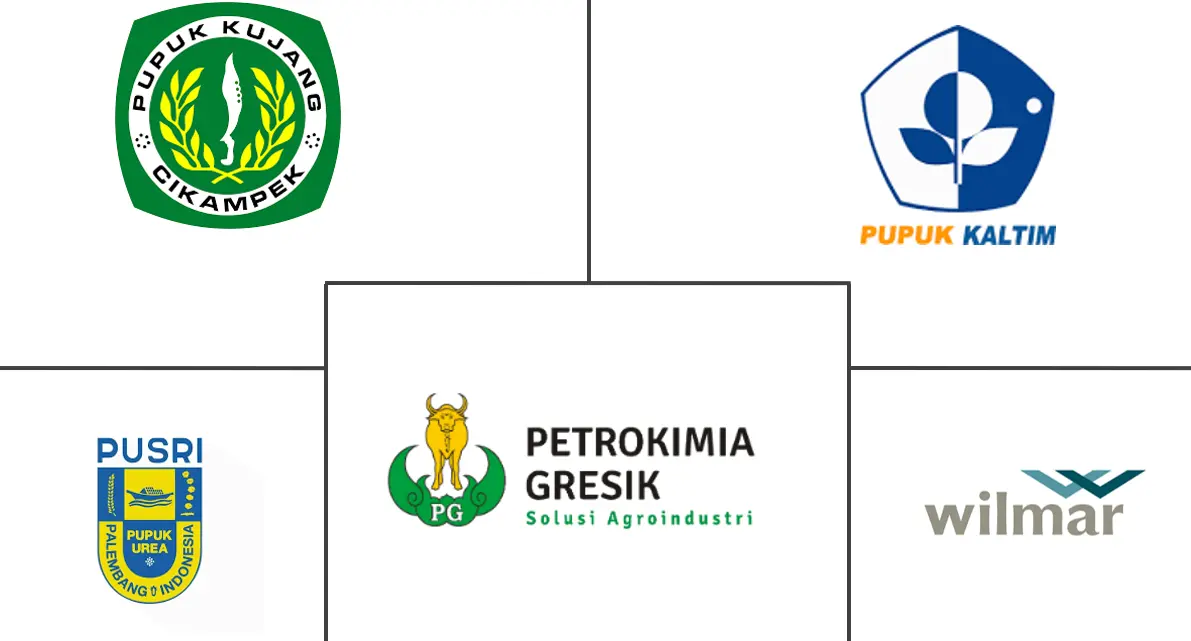Market Size of Indonesia Fertilizer Industry

| Study Period | 2019 - 2029 |
| Base Year For Estimation | 2023 |
| Market Size (2024) | USD 8.47 Billion |
| Market Size (2029) | USD 12.14 Billion |
| CAGR (2024 - 2029) | 6.00 % |
| Market Concentration | High |
Major Players
*Disclaimer: Major Players sorted in no particular order |
Indonesia Fertilizer Market Analysis
The Indonesia Fertilizer Market size is estimated at USD 8.47 billion in 2024, and is expected to reach USD 12.14 billion by 2029, growing at a CAGR of 6% during the forecast period (2024-2029).
The COVID-19 pandemic had the most critical impact on the fertilizer industry in the country. Production went down by 20-30%, and prices increased due to supply constraints. The industry also suffered from severe labor shortages due to repeated lockdowns that affected the production, export, and import business. A large part of the industry was shut down from the end of January 2020, limiting both demand and supply of all relevant inputs, as transport and storage constraints presented mounting challenges across the sector.
Over the long term, Indonesian fertilizer production has been anticipated to expand continuously. In the case of basic and widely available fertilizers such as urea-based fertilizers, production capacities have recently increased significantly in the country. The domestic increase in demand in this regard comes primarily from the plantation industry. Indonesia is the world's third-largest exporter of rubber and cocoa. An increase in export-oriented cultivation of plantation crops led to an increased demand for fertilizers in the commercial crops segment. Indonesia is one of the world's largest importers of fertilizers.
Further, the Ministry of Agriculture of Indonesia (MOA) regulates and monitors standards that affect farmer productivity, such as possessing and using fake fertilizer, bad seed, and dangerous pesticides off the market, in order to eliminate the root cause of decreased land productivity.
The nitrogenous segment is considered the largest segment of the market and accounts for a major share among other segments. Urea is the most-traded nitrogenous fertilizer. There is high demand for exports of urea fertilizers from several countries, such as Vietnam, Singapore, Thailand, and the Philippines, which augments the demand for the production of urea fertilizers in the country.
Therefore, with the increasing food demand and growing population, the country requires much effort to improve food crop productivity. This can be achieved by rising cropping intensity and providing the appropriate fertilizers. Therefore, these factors are anticipated to drive the market and aid in registering positive growth during the forecast period.
Indonesia Fertilizer Industry Segmentation
Fertilizers are natural or artificial substances containing chemical elements that improve the growth and productiveness of plants. Fertilizers enhance the soil's natural fertility or replace the chemical elements taken from the soil by previous crops. Modern fertilizers include nitrogenous, potash, and phosphate fertilizers. Some fertilizers also contain certain "micronutrients" such as zinc and other metals that are necessary for plant growth.
The Indonesia fertilizer market is segmented by type Complex, Straight (nitrogenous, phosphatic, potash, secondary nutrient, and micronutrients), crop type (grains and cereals, pulses and oilseeds, commercial crops, fruits and vegetables, and Turf and Ornamental crops). The report offers a market estimation and forecasts of the market size in value (USD million) and volume (metric ton) for all the mentioned segments.
| Straight Fertilizers | ||||||||
| ||||||||
| ||||||||
| ||||||||
| Secondary Nutrient Fertilizers | ||||||||
| Micronutrients |
| Crop Type | |
| Grains and Cereals | |
| Pulses and Oil Seeds | |
| Commercial Crops | |
| Fruits and Vegetables | |
| Turf and Ornamental Crops |
Indonesia Fertilizer Market Size Summary
The Indonesia fertilizer market is poised for significant growth over the forecast period, driven by increasing demand from the agricultural sector, particularly in plantation crops such as rubber and cocoa. The market has shown resilience despite challenges posed by the COVID-19 pandemic, which led to production declines and supply chain disruptions. The government's regulatory efforts, through the Ministry of Agriculture, aim to enhance agricultural productivity by ensuring the availability of quality fertilizers and addressing issues like counterfeit products. The nitrogenous segment, especially urea, dominates the market due to its extensive use in various crops and strong export demand from neighboring countries. The expansion of arable land and the adoption of modern farming practices further contribute to the rising fertilizer consumption, supporting the market's positive trajectory.
The market landscape is characterized by a high level of consolidation, with state-owned enterprises and key players like PT Pupuk Indonesia Holding Company leading the industry. These companies are actively pursuing strategic partnerships to strengthen their market positions. The increasing need for crop intensification to meet the demands of a growing population underscores the importance of fertilizers in enhancing food security. As Indonesia continues to expand its agricultural capabilities, the fertilizer market is expected to experience robust growth, supported by both domestic demand and export opportunities. The ongoing developments in agricultural production systems, coupled with the strategic initiatives by major market players, are anticipated to drive the market forward during the forecast period.
Indonesia Fertilizer Market Size - Table of Contents
-
1. MARKET DYNAMICS
-
1.1 Market Overview
-
1.2 Market Drivers
-
1.3 Market Restraints
-
1.4 Porter's Five Forces Analysis
-
1.4.1 Bargaining Power of Suppliers
-
1.4.2 Bargaining Power of Buyers
-
1.4.3 Threat of New Entrants
-
1.4.4 Threat of Substitute Products
-
1.4.5 Intensity of Competitive Rivalry
-
-
-
2. MARKET SEGMENTATION
-
2.1 Complex Fertilizers
-
2.2 Straight Fertilizers
-
2.2.1 Nitrogenous Fertilizers
-
2.2.1.1 Urea
-
2.2.1.2 Calcium Ammonium Nitrate (CAN)
-
2.2.1.3 Ammonia
-
2.2.1.4 Ammonium Nitrate
-
2.2.1.5 Ammonium Sulfate
-
2.2.1.6 Other Nitrogenous Fertilizers
-
-
2.2.2 Phosphatic Fertilizers
-
2.2.2.1 Mono-ammonium Phosphate (MAP)
-
2.2.2.2 Di-ammonium Phosphate (DAP)
-
2.2.2.3 Triple Superphosphate (TSP)
-
2.2.2.4 Other Phosphatic Fertilizers
-
-
2.2.3 Potash Fertilizers
-
2.2.3.1 Muriate of Potash (MOP)
-
2.2.3.2 Other Potash Fertilizers
-
-
2.2.4 Secondary Nutrient Fertilizers
-
2.2.5 Micronutrients
-
-
2.3 Crop Type
-
2.3.1 Grains and Cereals
-
2.3.2 Pulses and Oil Seeds
-
2.3.3 Commercial Crops
-
2.3.4 Fruits and Vegetables
-
2.3.5 Turf and Ornamental Crops
-
-
2.4
-
Indonesia Fertilizer Market Size FAQs
How big is the Indonesia Fertilizer Market?
The Indonesia Fertilizer Market size is expected to reach USD 8.47 billion in 2024 and grow at a CAGR of 6% to reach USD 12.14 billion by 2029.
What is the current Indonesia Fertilizer Market size?
In 2024, the Indonesia Fertilizer Market size is expected to reach USD 8.47 billion.

